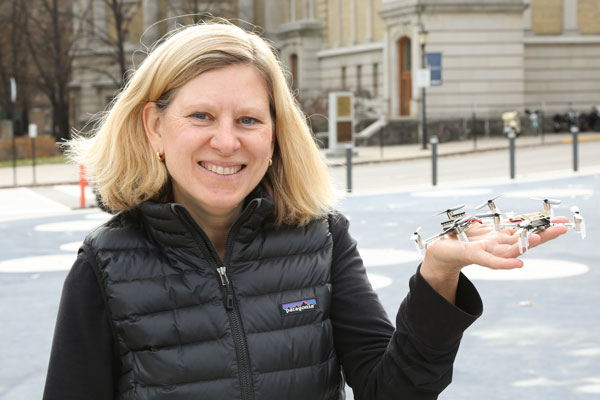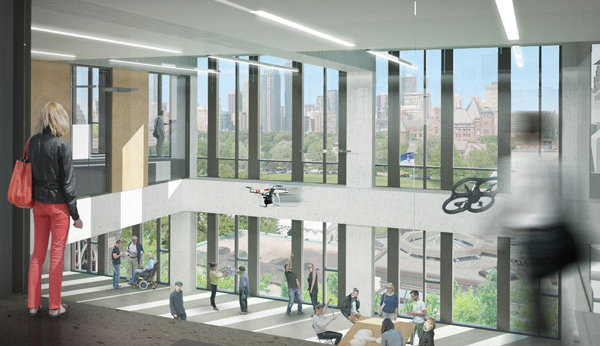
December 4, 2017
Tyler Irving
Autonomous robots need to do more than just drive, fly or swim directly from A to B: to arrive safely, they must continually adjust their paths to account for obstacles and changing conditions. Professor Mireille Broucke (ECE) has spent years developing theoretical control frameworks that can do just that. Now, she’s finding a wealth of situations where they can be applied, from self-driving cars to drones.
Robotics and control theory are in Broucke’s blood; her father worked at NASA’s Jet Propulsion Laboratory and she grew up hearing stories about successful (and unsuccessful) space missions. In her own work, she is driven by a desire to address problems that traditional approaches simply can’t handle.
“For a long time, control theory focused on standard specifications like set-point stabilization,” says Broucke. Cruise control is an example: it raises or lowers the gas pedal to keep a car at a constant speed. But what if another car suddenly pulls in front? “All of a sudden, logic comes in — there are if/then rules. Traditional control theory doesn’t account for that, and the human operator has to intervene.”
Broucke and her team focus on control algorithms that do account for these kinds of disturbances, adapting to new information or changing circumstances. They also incorporate mechanisms that “disallow bad behaviour,” that is, prevent the system from doing something unsafe. “It’s like an invisible shield that pushes against the danger zones,” she says.
An adaptive cruise control system, such as the one created by Broucke and her students, is capable of slowing down or speeding up to match the speed of the car in front. It can even decide when it’s time to change lanes and overtake, all while obeying speed limits. Another algorithm developed by the team executes a perfect parallel park in just two movements. “As long as you arrive in the general vicinity, a certain bounded box, we can finish the manoeuvre,” says Broucke.
So far, these automotive algorithms have only been tested in simulation. More recently, Broucke collaborated with Professor Angela Schoellig (UTIAS) on a project that used flying robots as a test bed for path-planning algorithms.
Watch drones powered by Broucke’s control algorithms navigate a maze to deliver a treat to Akela the dog.
“The quadrocopter is able to fly through a space cluttered with students and equipment and deliver a payload. In this case, it’s a treat for Akela, my dog,” says Broucke. The controllers are flexible enough to handle disturbances such as a sudden gust of wind. In the future, they could be used to power drones conveying goods in crowded urban areas — think flying pizza delivery.
Both Brocke and Schoellig are members of U of T’s Institute for Robotics and Mechatronics (IRM), which facilitates collaborative research projects and innovative educational programs in this rapidly growing field. IRM is one of several multidisciplinary research institutes that will soon have a new home in the Centre for Engineering Innovation & Entrepreneurship, set to open in spring 2018.
“It’s a beautiful space: a two-storey lab with viewing platforms where people will see mobile robots, medical robots and flying robots in action,” says Broucke. “It will be inspiring for undergraduate students, for graduate students, for industry partners and alumni, providing a glimpse of what will be possible with robotics in the near future.”

This story originally appeared on U of T Engineering News.
More information:
Jessica MacInnis
Senior Communications Officer
The Edward S. Rogers Sr. Department of Electrical & Computer Engineering
416-978-7997; jessica.macinnis@utoronto.ca